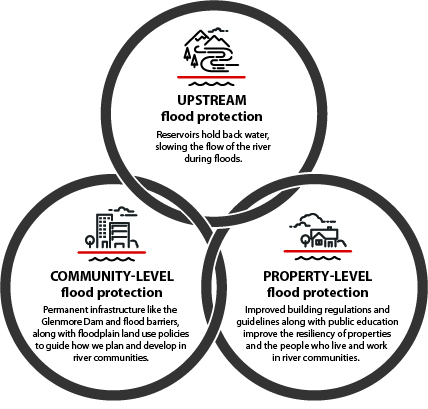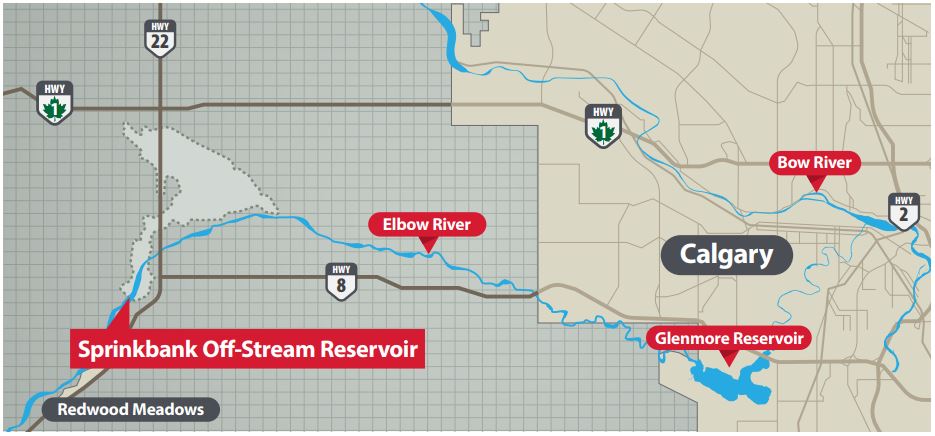Calgary's Flood Resilience Plan
As a river city, we will always need to prepare, respond and adapt to floods. Building resilience to flooding is one of our top priorities.
Calgary’s flood resilience plan uses a three-layered approach where all the elements working together can help reduce our flood risk and make Calgary more resilient.
Upstream flood protection on the Bow and Elbow Rivers:
Reservoirs hold back water, slowing the flow of the river during floods.
Community-level flood protection:
Permanent flood mitigation infrastructure, like the Glenmore Dam and flood barriers, along with floodplain land use policies to guide how we plan and develop in river communities.
Property-level flood protection:
Improved building regulations and guidelines along with public education help improve the resilience of properties and the people who live and work in river communities.

Every spring, we actively monitor the rivers for flooding. We also continuously improve our flood forecasting to provide Calgarians with the earliest possible warning.
Our flood emergency response measures are updated every year, ensuring we’re ready to respond quickly.
-
2022 Flood Resiliency and Mitigation Annual Update
Learn what progress we’ve made in our -
Developing Calgary's Flood Resilience Plan
To learn more about how the plan was created
Building flood resilience on the Elbow River
Upstream flood protection
Springbank Reservoir (SR1)
Calgary’s Elbow River communities are now protected from 2013-sized floods, thanks to the new Springbank Off-Stream Reservoir (SR1) located along the Elbow River, upstream of Calgary. This Government of Alberta project is a “dry reservoir” that only holds water during floods.
During a flood, some water will be diverted from the Elbow River into the reservoir, where it can be temporarily stored and released slowly back into the Elbow River. It will work together with the Glenmore Reservoir to significantly increase the overall floodwater storage capacity on the Elbow River.
Community-level flood protection
Glenmore Dam Gates
By installing new, 2.5 metre high steel gates at the Glenmore Dam, we’ve doubled the water storage capacity, which improves our ability to control high river flows in the spring on the Elbow River.
Building flood resilience on the Bow River
Upstream flood protection
New upstream reservoir on the Bow River
This Government of Alberta project on the Bow River would capture water from large floods and could provide seasonal water supply in the face of climate uncertainty and risk of drought.
In 2024, the Government of Alberta announced the advancement of the relocated Ghost Dam option to Phase 3 Engineering & Regulatory approvals. The concept includes relocating the current Ghost Dam slightly downstream to increase the size of the existing reservoir and the amount of water that can be stored during floods or times of water shortages.
An upstream reservoir on the Bow River is critical for Calgary’s long-term flood and drought resilience. Having this upstream water storage solution will help ensure a secure water supply, while managing flood and drought risks in a changing climate.
Modified operations at TransAlta’s Ghost Reservoir
This agreement between the Government of Alberta and TransAlta has the Ghost Reservoir kept low during flood season to help control the flow of water through Calgary and significantly reduces Calgary’s risk of flooding.
Status: The agreement to modify operations at Ghost Reservoir for flood mitigation purposes from May to July is in place until 2026.
Community-level flood protection
Permanent flood barriers
Permanent flood barriers in low-lying areas will work with a future upstream reservoir to increase resiliency to flooding.
- Inglewood
- West Eau Claire (from the Peace Bridge to Eau Claire Plaza)
- Downtown (from Jaipur Bridge to the Reconciliation Bridge)
- Sunnyside-Hillhurst
- Heritage Drive
- Bonnybrook Wastewater Treatment Plant
Until a new upstream reservoir is built on the Bow River, community flood barriers also protect the communities from smaller floods that are more likely to happen.
Status: Work on the individual flood barrier projects are in various stages of design, community engagement or construction.
Other mitigation projects: In addition, stormwater and sanitary system improvements, gravel bar removals and bridge improvements have improved overall flood resiliency in Calgary.
Flood mitigation projects in Calgary
Since the 2013 flood, with support from the Government of Alberta over $1.3 billion has been invested in flood mitigation and resilience projects throughout Calgary.
Mitigation work that is already complete or is underway has reduced Calgary’s flood risk by approximately 70 per cent and our flood damages by $118 million every year.
See a list of some of the projects we’ve been working on below, or check out our interactive flood project map.
River flood resilience projects
| Project | Completion timeline |
|---|---|
| Completed |
River flood mitigation barriers
| Projects | Completion timeline |
|---|---|
|
Centre St Bridge: flood barrier |
Completed |
|
Heritage Dr S.E.: flood barrier |
Completed |
| Completed | |
|
Substantially completed 2025 |
|
|
2026 |
|
|
Completed |
|
Stormwater system improvements
| Projects | Completion timeline |
|---|---|
| Completed | |
| Completed | |
|
All flood-related improvements completed |
|
|
Bonnybrook Wastewater Treatment Plant (WWTP): outfalls and utility relocation |
Completed |
Bridge improvements
| Project | Completion timeline |
|---|---|
|
9 Avenue S.E. |
Completed |
Gravel bar & bank stabilization projects
| Projects | Completion timeline |
|---|---|
| Completed | |
|
Downstream of Centre Street Gravel Bar Modification |
Completed |
|
Mission Island: Elbow River gravel bar |
Completed |
|
Crowchild Trail NW: Bow River gravel bar |
Completed |
|
Scollen Bridge: Elbow River gravel bar |
Completed |
|
|
In design |
Sanitary system improvements
| Projects | Completion timeline |
|---|---|
|
Roxboro Sanitary Liftstation |
Completed |
|
Completed |
Other civic projects
| Projects | Completion timeline |
|---|---|
|
Municipal Complex: drainage improvements |
Completed |
|
Zoo flood mitigation |
Completed |
Elbow and Bow River communities
Community-level flood protection
Calgary’s land use policies use provincial flood hazard maps to guide how and where types of development can occur and limit new flood risk caused by growth. For example, new development is not allowed in the floodway, the zone of highest flood risk.
Policies intended to reduce flood risk are included in plans such as the Municipal Development Plan and the Calgary River Valleys Plan.
Property- level flood protection
Many of Calgary’s older communities were built on river floodplains. Over the decades, as our understanding of the flood risk in these areas has improved, it has led to safer building practices.
Today, some property-level flood-proofing is required through building regulations during renovations and new builds. Measures may include:
- Installing sump pumps and backflow valves
- Elevating furnaces and electrical panels
Other voluntary actions can further reduce damages to homes, such as installing water alarms in the basement, finishing the basement with easy-to-clean materials and repairing. Get more tips for reducing flood damage.
We also have a Flood Readiness Guide and seasonal newsletter, and we are exploring new programs to help residents flood-proof their property and be prepared for flooding.


